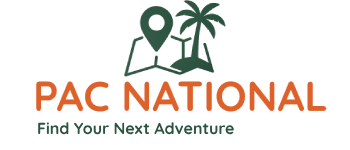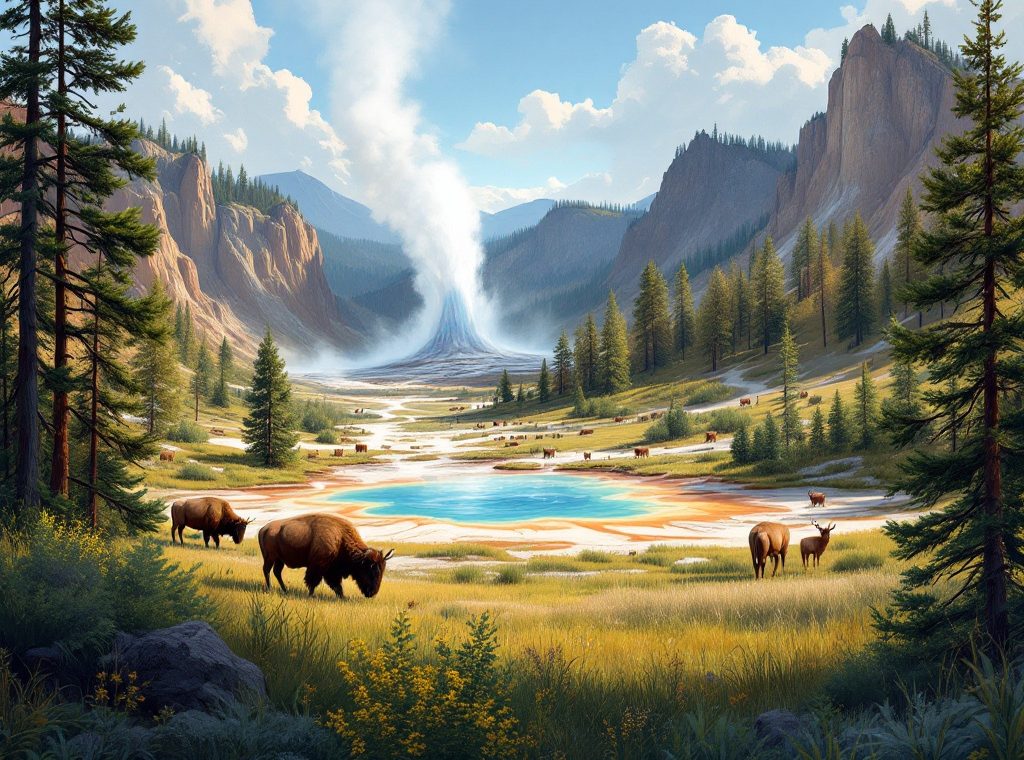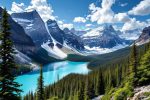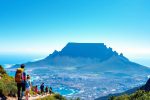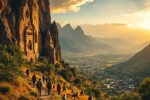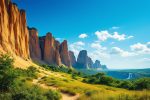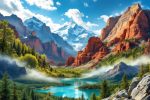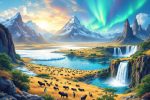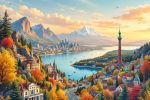How to Plan Your Trip with These Essential Yellowstone Travel Tips
Dream of witnessing Old Faithful erupt? Yellowstone National Park, spanning Wyoming, Montana, and Idaho, awaits! Discover a geothermal wonderland with vibrant springs, diverse wildlife, and breathtaking canyons. Plan your adventure now with our comprehensive guide, covering everything from itinerary suggestions and reservation tips to safety guidelines and insider secrets. Start exploring Yellowstone today!
Important information
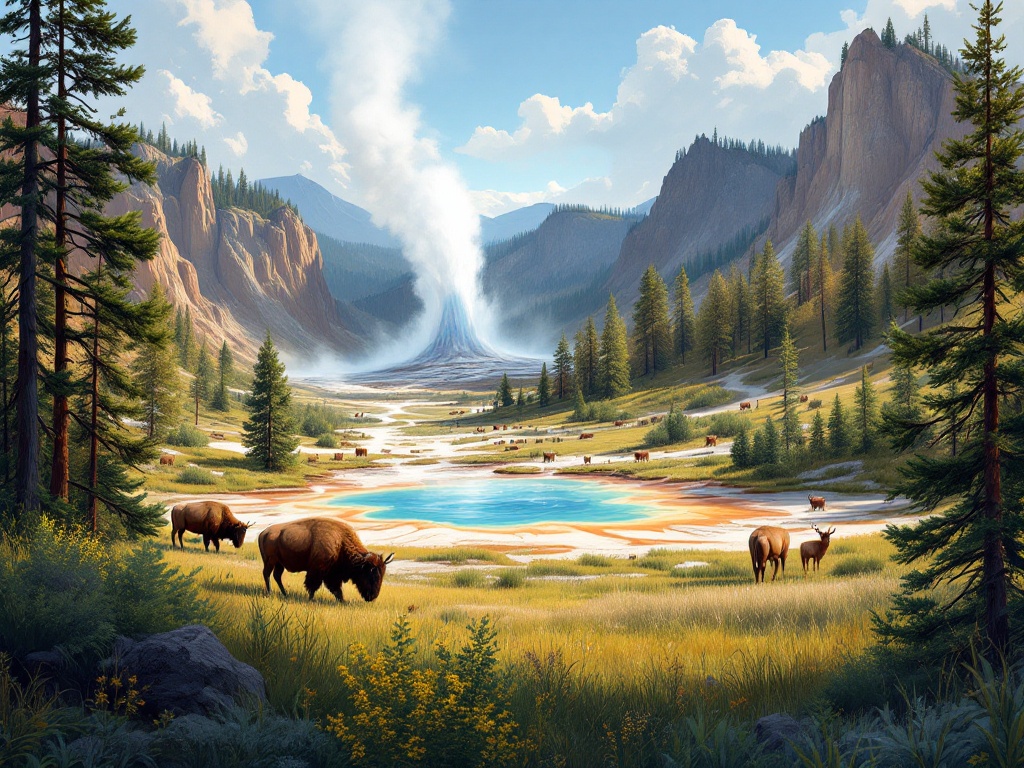
- Book accommodations, tours, and activities well in advance, especially during peak season.
- Rent a car (SUV or truck recommended) and reserve it early. Check road conditions on the park’s website before and during your trip.
- Be prepared for unpredictable weather. Pack layers, sturdy hiking boots, rain gear, and sun protection.
- Cell service is limited. Download offline maps and resources before entering the park. WiFi is available in developed areas.
- Wildlife is abundant. Stay 100 yards from bears and wolves, and 25 yards from other animals. Carry bear spray and know how to use it.
Introduction to Planning Your Trip to Yellowstone
Planning your Yellowstone Adventure
Consider the ideal time to visit, balancing pleasant weather with manageable crowds.
Determine the length of your stay, which will influence lodging and transportation options within the vast park.
Explore the park map beforehand to pinpoint key attractions and prime wildlife viewing areas.
Create a basic itinerary to ensure efficient use of your time.
Familiarize yourself with park regulations and safety guidelines, especially regarding wildlife interactions.
Book accommodations, tours, and activities well in advance to avoid disappointment, as they tend to fill up quickly.
Understanding Yellowstone’s Key Features
Yellowstone National Park, located mainly in northwestern Wyoming, stretches into Montana and Idaho. Five entrances—North, Northeast, South, East, and West—allow access for visitors arriving from different directions.
Location and Entrances
Yellowstone National Park spans across Wyoming, Montana, and Idaho, and is accessible through five entrances. The North Entrance is located in Gardiner, Montana. The Northeast Entrance is situated in Cooke City, Montana. Visitors can also enter from the East Entrance in Cody, Wyoming, or through the South Entrance, connecting to Grand Teton National Park. The West Entrance is located in West Yellowstone, Montana.
Geological and Geothermal Features
Yellowstone National Park is a geothermal wonderland. Its most famous geyser, Old Faithful, erupts with remarkable regularity. The Grand Prismatic Spring dazzles visitors with its vibrant rainbow hues. Bubbling mud pots further enhance this unique landscape, all powered by the park’s massive volcanic caldera. It’s a truly remarkable sight.
Wildlife and Safety Guidelines
Respect wildlife by maintaining a safe distance. Stay at least 100 yards away from large predators like bears and wolves, and 25 yards away from other animals such as bison and elk. Carry bear spray and familiarize yourself with its proper usage. Store food properly and dispose of trash in designated receptacles to avoid attracting animals. When near geothermal features, remain on boardwalks and designated trails. Be mindful of your surroundings and adhere to park regulations for everyone’s safety.
Getting to Yellowstone: Travel and Accessibility
Planning your Yellowstone adventure? Start with booking your flights and rental car. Several airports provide convenient access to the park:
- Bozeman Yellowstone International (BZN),
- Yellowstone Regional (COD),
- Idaho Falls Regional (IDA),
- Jackson Hole (JAC).
While rental cars are available at each airport, reserving in advance is highly recommended, especially during peak season. This also applies to accessible vehicles; contact rental agencies beforehand to ensure availability. Driving distances within Yellowstone can vary greatly depending on your chosen entrance and destination. Check the park website for the latest road conditions and updates before your trip, as conditions can change quickly due to weather.
Best Airports and Car Rentals
Planning your trip to Yellowstone National Park starts with choosing the right airport. Several airports offer convenient access to the park, depending on your target entrance and preferred mode of transportation.
Closest Airports to Yellowstone
- For the north entrance: Bozeman Yellowstone International Airport (BZN) is your best bet.
- Traveling to the south entrance? Jackson Hole Airport (JAC) in Wyoming offers the most direct route.
Other Airport Options
- Idaho Falls Regional Airport (IDA) and Yellowstone Regional Airport (COD) provide additional access points.
Renting a car is highly recommended for exploring Yellowstone. All the mentioned airports offer rental services, but reserving in advance is crucial, especially during peak season. An SUV or truck is ideal for navigating park roads.
Driving Distances and Road Conditions
Planning a Yellowstone trip? Be aware that driving distances within the park can be substantial. Before you go, it’s crucial to check current road conditions, as they can change rapidly, particularly during winter. Construction projects or inclement weather may lead to unexpected closures or delays. The official Yellowstone National Park website provides the most up-to-date information.
Vehicle Reservations and Accessibility Options
While reservations aren’t required to drive into Yellowstone, some areas limit private vehicles. Consider using the park’s shuttle system or a guided tour for easier access to the numerous attractions.
Seasonal Considerations for Your Yellowstone Visit
Spring (April-May)
Experience Yellowstone with fewer crowds and blooming wildflowers, alongside newborn wildlife. Note that some roads may still be closed.
Summer (June-August)
Enjoy warm weather and full park access, ideal for wildlife viewing, but expect large crowds.
Fall (September-October)
See vibrant foliage and the elk mating season, though visitor numbers decrease and some facilities begin to close.
Winter (November-March)
Explore a serene, snowy landscape perfect for snowshoeing and cross-country skiing, offering unique wildlife viewing opportunities. Many roads close to regular vehicles, making snowcoaches and snowmobiles the primary mode of transport.
Best Time to Visit
For a pleasant visit with fewer crowds, consider early June or September. These months offer comfortable temperatures and fully operational park facilities.
Weather Variability and Preparedness
Visiting Yellowstone National Park requires preparation for its unpredictable weather. Check weather forecasts frequently before and during your trip. Dressing in layers is essential for adapting to changing conditions. Start with a moisture-wicking base layer, add an insulating mid-layer like fleece, and top it off with a waterproof and windproof jacket. Comfortable and sturdy hiking shoes are crucial for navigating the park’s trails. Don’t forget essential sun protection, including sunscreen, hats, and sunglasses. Pack rain gear, as showers can occur unexpectedly. Remember that changing weather conditions can impact road closures, so check the park’s website or call for accessibility information before heading out.
Seasonal Packing Essentials
Planning a Yellowstone trip requires strategic packing based on the season.
Summer
Summer days are warm, pack light clothing layers, but be prepared for rain with appropriate gear. Sturdy hiking boots, sun protection, and insect repellent are also essential.
Fall
Fall temperatures drop, requiring warmer layers like fleece or a light jacket.
Winter
Winter brings frigid conditions, demanding heavy coats, insulated pants, hats, gloves, and scarves.
Spring
Spring is unpredictable, so pack a mix of warm and cool weather clothing.
Regardless of the season, remember these essentials:
- Binoculars,
- a camera,
- bear spray,
- a first-aid kit,
- a reusable water bottle,
- a daypack.
Yellowstone Itinerary Planning
Planning your Yellowstone adventure? A well-crafted itinerary is key to maximizing your experience. A three or four-day trip provides a solid overview of the park’s highlights. For shorter visits, prioritize your must-see spots. Extended stays allow deeper exploration of areas like the geyser basins or hiking trails. Account for travel time between destinations, factoring in your preferred activities and some downtime. Embrace flexibility, allowing you to adapt to unexpected delays and enjoy spontaneous discoveries.
How Much Time You Need
A three- or four-day trip to Yellowstone offers enough time to experience the park’s highlights and diverse landscapes. For a more in-depth exploration, including hikes on less-traveled trails and ample wildlife viewing opportunities, consider a week or longer. This extended stay will allow you to truly immerse yourself in Yellowstone’s wonders.
Itinerary Suggestions from 1 to 5 Days
Planning your Yellowstone Adventure: Suggested Itineraries
One Day in Yellowstone: Lower Loop Wonders. Focus on the Lower Loop, witnessing Old Faithful erupt and marveling at the Grand Prismatic Spring’s vibrant colors. Don’t miss Midway Geyser Basin for a rewarding day.
Two Days in Yellowstone: Lower and Upper Loops. Follow the one-day plan for your first day. Dedicate day two to the Grand Canyon of the Yellowstone and its stunning waterfalls, including a visit to Hayden Valley for potential bison and elk sightings.
Three Days in Yellowstone: Wildlife and Panoramic Views. Embark on the two-day itinerary for the first two days. On day three, explore Lamar Valley, a haven for wildlife, or hike up Mount Washburn for breathtaking panoramic vistas.
Four Days in Yellowstone: Deeper Exploration. Follow the three-day itinerary. Use your fourth day to delve deeper into areas of specific interest, perhaps enjoying activities like horseback riding or fishing.
Five Days in Yellowstone: Comprehensive Exploration. Enjoy extensive exploration of various trails and scenic drives. Capture stunning photos and consider venturing along the Beartooth Highway, just outside the park’s Northeast Entrance, for more breathtaking views.
Organizing Your Itinerary for Maximum Efficiency
Plan your routes to minimize driving time and maximize your experience. Start your day early to beat the crowds and take advantage of the golden morning light for stunning photos. Visit the visitor centers for valuable resources, including the latest park information, maps, and ranger-led programs. Enhance your visit with a guided tour focusing on the park’s unique ecology and rich history. Consider centrally located lodging to save travel time, but remain adaptable and embrace unexpected discoveries. Be sure to pack layers to accommodate changing weather conditions.
Reservations: Essential Tips
Plan your Yellowstone adventure in advance. Lodging and campsites are popular, especially during peak season, so reserve early. For campsites, arrive early in the day to secure a spot, or consider visiting during the quieter off-season. Check availability and book your accommodations online. Yellowstone National Park requires entrance fees, but several pass options are available. The park offers diverse dining options, from restaurants to designated picnic areas.
Lodging and Campground Reservations
Plan your Yellowstone National Park visit early, as accommodations fill up quickly. Inside-the-park options, including camping, cabins, hotels, and lodges, require advance booking, especially during peak season. If in-park lodging is unavailable, consider nearby towns like Gardiner and West Yellowstone, Montana, offering convenient access to the park. Check availability online and book your lodging early to secure your preferred choice.
Entrance Fees and Park Pass Options
Planning a trip to Yellowstone? Here’s a quick guide to entrance fees:
Vehicle Pass (7-Day)
$35 per vehicle.
Individual Pass (7-Day)
$20 per person.
For frequent park visitors, the America the Beautiful Pass offers exceptional value. At $80, this pass grants year-long access to all US national parks and federal recreational areas.
Dining and Picnic Areas
Yellowstone National Park offers diverse dining experiences, from restaurants and cafes to snack bars and picnic areas. Pack your own lunch and savor it surrounded by nature’s splendor at one of the many designated picnic spots, complete with tables and facilities. For restaurant locations, operating hours, and menus, check the park’s website or maps.
Activities and Attractions in Yellowstone
Explore Yellowstone National Park’s geothermal wonders, from the legendary Old Faithful geyser to the vibrant Grand Prismatic Spring and bubbling mud pots. Discover diverse geothermal areas, including the Upper, Midway, and Lower Geyser Basins.
Step back in time at Fort Yellowstone, a preserved army post, and explore historic accommodations like the Old Faithful Inn and Lake Yellowstone Hotel. These landmarks offer a glimpse into the park’s early tourism era.
Enrich your visit with ranger programs covering geology, ecology, and Yellowstone’s captivating history. Discover the heritage of affiliated tribes through seasonal Indigenous cultural events held throughout the park.
Must-See Attractions: Geysers, Basins, and More
Old Faithful erupts with predictable regularity, a captivating wonder.
The Grand Prismatic Spring dazzles with an array of vibrant colors, a true spectacle of nature.
The Grand Canyon of the Yellowstone astounds visitors with its breathtaking waterfalls.
Norris Geyser Basin presents a diverse range of geothermal features, from bubbling mud pots to steaming fumaroles.
Lamar Valley teems with wildlife, offering glimpses of bison and elk.
Mammoth Hot Springs showcases unique terraced formations, a geological marvel.
Historic Fort Yellowstone provides a window into the park’s past.
Yellowstone Lake invites visitors to enjoy boating and fishing in a serene setting.
Exploring Historic Places and Lodges
Experience the grandeur of Yellowstone National Park by staying in one of its historic hotels. Choose from iconic lodgings such as the Old Faithful Inn, Lake Yellowstone Hotel, and Mammoth Hot Springs Hotel. These architectural gems offer a unique blend of history, stunning design, and convenient access to the park’s main attractions. Book your stay well in advance as these popular accommodations fill up quickly.
Ranger Programs and Indigenous Cultural Events
Discover Yellowstone National Park through a variety of enriching experiences. Explore the park’s captivating geology, ecology, and history with park ranger-led tours, talks, and walks. Immerse yourself in the natural beauty of Yellowstone alongside expert guides. Experience Indigenous cultural events showcasing the history and traditions of affiliated tribes. Enjoy captivating demonstrations, storytelling, and exhibits, and learn about traditional crafts and ancient legends. For detailed schedules and activity information, visit the park’s website or inquire at visitor centers to plan your Yellowstone adventure.
Enhancing Your Yellowstone Experience
Enhance your Yellowstone experience by capturing breathtaking photos. To do this, understand the park’s distinct lighting and wildlife behavior. Useful travel apps offer navigation and real-time updates on road conditions and geyser activity. Ranger-led programs grant deeper insights and access to exclusive viewpoints, often unveiling hidden trails and secluded gems. Engaging with local communities enriches your trip by revealing the park’s captivating history and culture. Embrace spontaneity—perhaps discovering a new trail or witnessing a surprise geyser eruption. For a unique perspective, consider visiting during the off-season, but be prepared for unpredictable weather.
Capture stunning photos: Learn about the park’s unique lighting and animal behavior to take breathtaking pictures.
Utilize travel apps: Handy travel apps offer navigation and real-time updates on road conditions and geyser activity.
Join ranger programs: Ranger programs provide deeper insights and access to exclusive viewpoints, often leading you to hidden trails and secluded gems.
Connect with local communities: Connecting with local communities enriches your trip by revealing the park’s captivating history and culture.
Embrace spontaneity: Embrace spontaneity—perhaps discovering a new trail or witnessing a surprise geyser eruption.
Consider the off-season: For a unique perspective, consider visiting during the off-season, but be prepared for unpredictable weather.
Photography and Wildlife Observation Tips
Enhance your wildlife viewing experience with binoculars or a spotting scope, ensuring both a clear view and your safety.
Maintain a safe distance from animals—100 yards for bears and wolves, and 25 yards for others.
Respect wildlife by avoiding disturbances.
Early mornings and late afternoons offer ideal lighting and increased animal activity, perfect for photography.
A telephoto lens helps capture stunning shots from afar.
Compose your photos thoughtfully, incorporating captivating backgrounds and foregrounds.
Remember to adhere to park regulations regarding wildlife photography.
Travel Apps and Guides for Roadtrippers
Planning your road trip? Here’s how to choose the best navigation resources:
Navigation Apps
- Google Maps provides turn-by-turn directions and real-time traffic updates.
- Waze offers community-based traffic and hazard reporting.
- Maps.me allows for offline map usage, ideal for areas with limited connectivity.
Park-Specific Resources
- Official park apps (e.g., Yellowstone National Park app) offer detailed park information, including trail maps and points of interest.
- Audio tours (e.g., Gypsy Guide) provide engaging narratives and insights into park history and geology.
Guidebooks
For comprehensive park information, consider:
- National Geographic’s Yellowstone and Grand Teton guide
Guidebooks
For a broader overview of western parks, try:
- Fodor’s Complete Guide to the National Parks of the West
Insider Tips for a Memorable Visit
Plan your itinerary around the key sights you want to see to maximize your Yellowstone experience.
Start your days early to avoid crowds and capture stunning photos with the best lighting.
Utilize visitor centers for helpful maps and ranger advice.
Consider a guided tour to deepen your understanding of the park’s wonders.
Choose centrally located lodging to minimize travel time and explore more efficiently.
Be open to unexpected adventures, as some of the most memorable moments happen spontaneously.
Research the park’s layout, including its geysers, hot springs, and prime wildlife viewing spots, before you go.
Pack layers, as Yellowstone’s weather can be unpredictable.
Familiarize yourself with park regulations for a safe and enjoyable visit.
Connectivity and Safety in Yellowstone
Staying Connected in Yellowstone
Cell service in Yellowstone is unreliable. Verizon and Union Wireless generally offer the best coverage, but it’s still limited. You’ll typically find service in developed areas such as Old Faithful, Canyon Village, and Grant Village. Some lodges offer Wi-Fi, but it can be slow due to high demand. Downloading offline maps and resources before your visit is highly recommended.
Weathering Yellowstone’s Unpredictability
Yellowstone’s weather is known for being unpredictable and can change rapidly. Before your trip, check the park’s website or call (307) 344-2117 for current road conditions. Carry chains in winter. Be prepared for snow or ice even during summer months, as some roads may close during storms for safety reasons.
Protecting Yourself and Yellowstone’s Wildlife
- Carry bear spray and know how to use it.
- Store food and scented items in bear-resistant containers, or securely in your car.
- Maintain a safe distance from wildlife: at least 25 yards from bison and elk, and 100 yards from bears and wolves.
- Never approach or feed wildlife.
- For your safety, carry a first-aid kit and inform someone of your hiking plans.
Cell Service and WiFi Availability
Cell phone service is unreliable in Yellowstone, so don’t expect a consistent signal.
WiFi is available in developed areas such as:
- Old Faithful,
- Canyon Village,
- Lake Yellowstone Hotel.
For a smooth trip, download offline maps and resources beforehand to ensure access to crucial information.
Weather-Related Road Status and Safety
Planning a Yellowstone trip? Check the park website or call for updates on road conditions and closures. Mountain weather changes rapidly and can be hazardous, so plan ahead for a safe and enjoyable visit.
Packing and Wildlife Safety Tips
Pack your clothes in layers to adapt to quickly changing temperatures.
Essential gear includes sturdy hiking boots and a waterproof jacket.
Don’t overlook vital items like sunscreen, insect repellent, and a first-aid kit.
In bear country, bear spray is a must-have.
A reusable water bottle and energy-boosting snacks will also come in handy.
Capture memories with a camera and enhance wildlife viewing with binoculars, but always maintain a safe distance from animals.
Never approach or feed them. Stick to marked trails, as wandering off can be dangerous.
Be mindful of your surroundings and store food properly to avoid attracting animals.
Remember to always carry bear spray while hiking.
